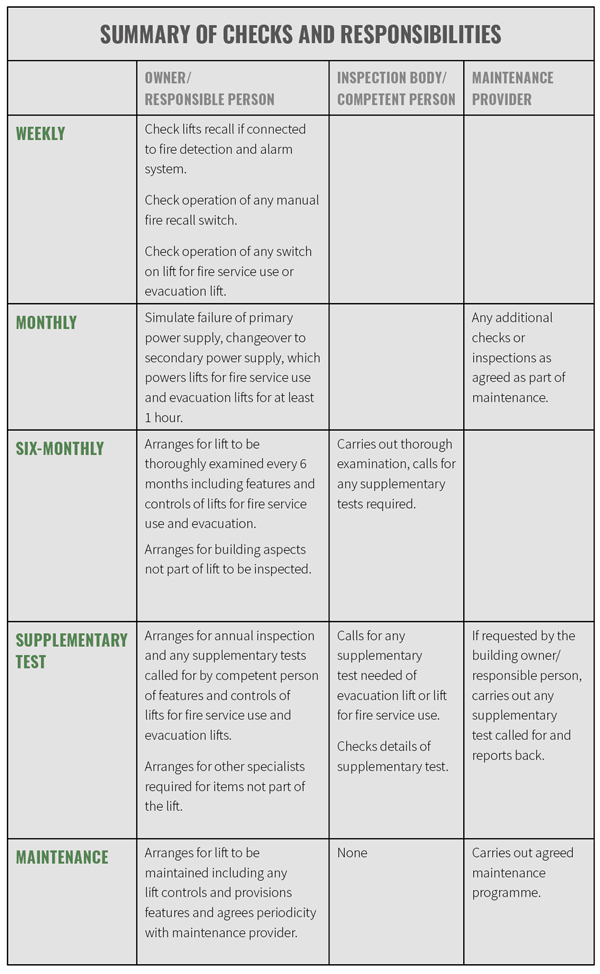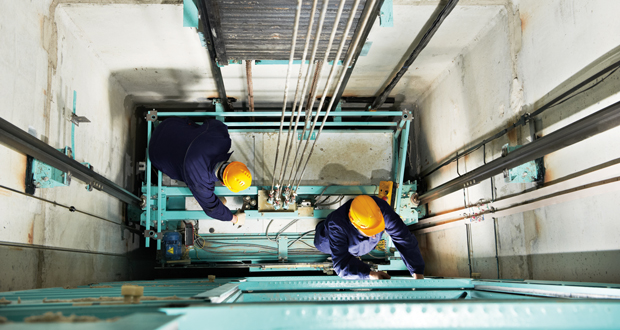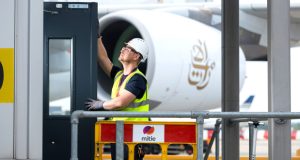As part of the changes to fire safety regulations there have been updates to the regulations regarding lifts. Ahead of LIFTEX 2022 in October, Nick Mellor, MD of LEIA and LIFTEX 2022 explains the existing guidance in British Standards.
The recently published Fire Safety (England) Regulations 2022 now requires “responsible persons” to undertake monthly checks on lifts for use by firefighters and evacuation lifts, along with other duties under the Regulatory Reform (Fire Safety) Order. It’s important to note that the new regulations impose requirements which should sit alongside and complement this existing regime under the Regulatory Reform (Fire Safety) Order 2005. A “responsible person” is the term used in the regulations and this might be the FM, building owner or a designated person.
British Standards guidance
There are British Standards which refer to the maintenance and inspection of lifts. BS 9999:2017, Annex I include recommendations for weekly, monthly and annual checks. These are echoed in BS 8899:2016, clause 8, which looks at routine inspection, maintenance and thorough examination of lifts for use by firefighters and evacuation lifts.
Weekly checks
These checks do not need specialist lift personnel and so would typically be carried out by the “responsible person”.
As part of the weekly checks of the fire detection and fire alarm systems, the recall of any lifts connected to the system should be checked which could include the following checks:
- Recall to the designated floor and removal from service of lifts not intended to stay in service.
- Recall to the fire service access level and removal from service until firefighters take control of lifts for use by firefighters (including firemen’s, firefighting and firefighters lifts).
- Recall to the exit floor and removal from service until evacuation operations commence of lifts intended to be used for the evacuation of disabled people.
- Operation of any manual lift recall switch should be checked weekly by the building owner/responsible person using their key to ensure that the lift car recalls to the designated floor and then goes out of service. Any fault should be reported to the lift maintenance provider to allow it to be investigated and rectified.
- Operation of any evacuation lift switch or firemen’s/firefighting/firefighters lift switch should be checked weekly by the building owner/responsible person using their key to ensure it recalls the lift car which is then only operates under evacuation / fire control. Any fault should be reported to the lift maintenance provider to allow it to be investigated and rectified.
Monthly checks
Again, these checks don’t need specialist lift personnel to be involved and so could typically be carried out by the “responsible person”. In addition to the above, the following should be checked on a monthly basis:
For lifts intended to be used by the fire services or for the evacuation of disabled people, a failure of the primary power supply should be simulated once a month. If a generator provides the standby power supply, it should energise the lift(s) for at least one hour.
The Fire Safety (England) Regulations will require routine monthly checks and at the time of writing guidance is still awaited on these. It is understood that these checks are intended to be undertaken by the responsible person and not to require specialist lift personnel.
Thorough examination of lifts in service
The building owner/responsible person should ensure that all features and functions of lifts for fire service use and/or evacuation lifts features are thoroughly examined periodically. This would typically be part of the thorough examination arranged with an inspection body and carried out by a ‘competent person’.
It is for the Competent Person (who carries out thorough examination) to determine the contents for thorough examination of these aspects but the example firefighters lift operational inspection report in BS 8899:2016, Annex D could be used as a basis.
The building owner/responsible person should ensure equipment that is not part of the lift is examined and tested where necessary on a similar schedule (such as power supplies, supply changeover equipment, any pit drainage pumps, water management, fire-fighting or evacuation communications systems, automatic recall devices, fire detection and alarm systems/BMS and interfaces to the lift equipment, external indicators and any labelling).
The Competent Person undertaking thorough examination may call for equipment that is not part of the lift to have supplementary testing carried out. The building owner/ responsible person should ensure that such supplementary testing is carried out (typically by the maintenance provider) and the results communicated to the competent person.
Supplementary tests called for by the competent person
SAFed’s Guidelines on the supplementary tests of in-service lifts, went through a significant revision with Issue 4 in June 2020. The guidelines include a new section at 4.18 for “other supplementary tests” which included recommendations for fire recall of lifts, lifts used for the evacuation of disabled people and lift for fire service use.
The guidelines recommend that unless there is evidence to show that such tests have been carried out during routine maintenance, it is recommended that these tests should be carried out at a periodic interval of 12 months unless it can be demonstrated that more frequent tests are required or that less frequent tests will be adequate to ensure safety.
The Competent Person should specify the detail of any test required and how they should be carried out taking account of the guidance in any OEM manuals and guidance available e.g. BS 8899. The Guidelines included Annex A.25 for an open format report of examination and test.
Examples of such components or functions, depending on the type of lift, may include:
- Fire recall function e.g. as BS EN 81-73 where this cannot be checked as part of thorough examination;
- Evacuation control and other aspects e.g. operation on secondary power supplies where this cannot be checked as part of thorough examination. See BS 8899:2016, clause 8 for recommendations on thorough examination;
- Firefighters control and other aspects e.g. operation on secondary power supplies where this cannot be checked as part of thorough examination. See BS 8899:2016, clause 8 and Annex D for an example of an annual firefighters lift operational inspection report.
Identifying lifts for fire service use/ evacuation lift types
There are several types of lifts for use by firefighters reflecting the development of standards over many decades. This has left a legacy of different types with different levels of protection and features. As part of their fire risk assessments, responsible persons may need to identify which type of lift they have. LEIA recently published guidance on Identifying lifts for use by firefighters and evacuation lift types in this area.
Summary of checks
 The table is a summary of checks referred to in this article with the different parties involved.
The table is a summary of checks referred to in this article with the different parties involved.
LIFTEX 2022, takes place 12 – 13 October 2022 at ExCeL, London www.liftexshow.com





